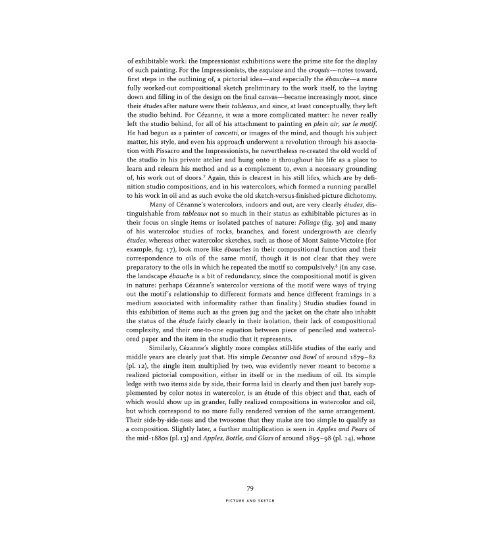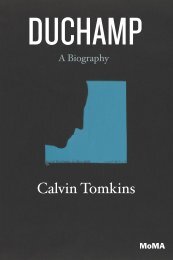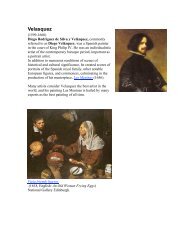Still Life in Watercolors
qbj8dgc
qbj8dgc
- No tags were found...
Create successful ePaper yourself
Turn your PDF publications into a flip-book with our unique Google optimized e-Paper software.
of exhibitable work: the Impressionist exhibitions were the prime site for the display<br />
of such pa<strong>in</strong>t<strong>in</strong>g. For the Impressionists; the esquisse and the croquis—notes toward,<br />
first steps <strong>in</strong> the outl<strong>in</strong><strong>in</strong>g of, a pictorial idea—and especially the ébauche—a more<br />
fully worked-out compositional sketch prelim<strong>in</strong>ary to the work itself, to the lay<strong>in</strong>g<br />
down and fill<strong>in</strong>g <strong>in</strong> of the design on the f<strong>in</strong>al canvas—became <strong>in</strong>creas<strong>in</strong>gly moot, s<strong>in</strong>ce<br />
their études after nature were their tableaux, and s<strong>in</strong>ce, at least conceptually, they left<br />
the studio beh<strong>in</strong>d. For Cézanne, it was a more complicated matter: he never really<br />
left the studio beh<strong>in</strong>d, for all of his attachment to pa<strong>in</strong>t<strong>in</strong>g en ple<strong>in</strong> air, sur le motif.<br />
He had begun as a pa<strong>in</strong>ter of concetti, or images of the m<strong>in</strong>d, and though his subject<br />
matter, his style, and even his approach underwent a revolution through his association<br />
with Pissarro and the Impressionists, he nevertheless re-created the old world of<br />
the studio <strong>in</strong> his private atelier and hung onto it throughout his life as a place to<br />
learn and relearn his method and as a complement to, even a necessary ground<strong>in</strong>g<br />
of, his work out of doors. 7 Aga<strong>in</strong>, this is clearest <strong>in</strong> his still lifes, which are by def<strong>in</strong>ition<br />
studio compositions, and <strong>in</strong> his watercolors, which formed a runn<strong>in</strong>g parallel<br />
to his work <strong>in</strong> oil and as such evoke the old sketch-versus-f<strong>in</strong>ished-picture dichotomy.<br />
Many of Cezanne's watercolors, <strong>in</strong>doors and out, are very clearly études, dist<strong>in</strong>guishable<br />
from tableaux not so much <strong>in</strong> their status as exhibitable pictures as <strong>in</strong><br />
their focus on s<strong>in</strong>gle items or isolated patches of nature: Foliage (fig. 30) and many<br />
of his watercolor studies of rocks, branches, and forest undergrowth are clearly<br />
études, whereas other watercolor sketches, such as those of Mont Sa<strong>in</strong>te-Victoire (for<br />
example, fig. 17), look more like ébauches <strong>in</strong> their compositional function and their<br />
correspondence to oils of the same motif, though it is not clear that they were<br />
preparatory to the oils <strong>in</strong> which he repeated the motif so compulsively. 8 (In any case,<br />
the landscape ébauche is a bit of redundancy, s<strong>in</strong>ce the compositional motif is given<br />
<strong>in</strong> nature: perhaps Cezanne's watercolor versions of the motif were ways of try<strong>in</strong>g<br />
out the motif's relationship to different formats and hence different fram<strong>in</strong>gs <strong>in</strong> a<br />
medium associated with <strong>in</strong>formality rather than f<strong>in</strong>ality.) Studio studies found <strong>in</strong><br />
this exhibition of items such as the green jug and the jacket on the chair also <strong>in</strong>habit<br />
the status of the étude fairly clearly <strong>in</strong> their isolation, their lack of compositional<br />
complexity, and their one-to-one equation between piece of penciled and watercolored<br />
paper and the item <strong>in</strong> the studio that it represents.<br />
Similarly, Cezanne's slightly more complex still-life studies of the early and<br />
middle years are clearly just that. His simple Decanter and Bowl of around 1879-82<br />
(pi. 12), the s<strong>in</strong>gle item multiplied by two, was evidently never meant to become a<br />
realized pictorial composition, either <strong>in</strong> itself or <strong>in</strong> the medium of oil. Its simple<br />
ledge with two items side by side, their forms laid <strong>in</strong> clearly and then just barely supplemented<br />
by color notes <strong>in</strong> watercolor, is an étude of this object and that, each of<br />
which would show up <strong>in</strong> grander, fully realized compositions <strong>in</strong> watercolor and oil,<br />
but which correspond to no more fully rendered version of the same arrangement.<br />
Their side-by-side-ness and the twosome that they make are too simple to qualify as<br />
a composition. Slightly later, a further multiplication is seen <strong>in</strong> Apples and Pears of<br />
the mid-i88os (pi. 13) and Apples, Bottle, and Glass of around 1895-98 (pi. 14), whose<br />
79<br />
PICTURE AND SKETCH




